Struggling with stubborn pests in your container garden? You’re not alone — pest control in container gardening needs a different approach than traditional ground gardening.
I’ve had my fair share of pest problems in my front yard ground gardening. But those pest problems were usually easy to handle — a few home remedies for garden pests or some pest control powders from local shops did the trick. Rarely did any plant die because of pest attacks. That’s mostly because they were native plant varieties, and many of them were small-sized tree-type plants with stronger resistance.
But in container gardening, the situation flipped.
Home remedies that worked in ground gardening didn’t always work here. The pest control powders or chemical pesticides for potted plants often backfired — sometimes making my plants wilt. And if I failed to notice just one pot with pests, it didn’t take long before the infestation spread. I wasn’t aware of proper plant spacing in containers back then, so the pest issue would often affect nearby pots. Some plants even died entirely because of the pests.
That’s when I learned the hard way: pest control in potted plants needs a customized approach.
If you think you’re a bad gardener just because you lost a plant to pests, hey — Hi, I’m the evil gardener.
I’ve lost plenty of plants to pest attacks in my early days. But now? I can spot the signs early and take action before it’s too late.
The truth is: pests in container gardens are almost unavoidable. Seasonal changes, unnoticed gaps in routine care, or even high humidity can trigger an outbreak. Feeling bad about it doesn’t help — what helps is developing pest-free gardening habits and learning how to care for plants after a pest attack.
The goal of natural pest control in container gardening is simple:
- Set up a few preventive pest care routines
- Use natural and safe pesticides for potted plants
- Understand what attracts pests — and how to avoid those traps
So, if your plants are under attack by pests or you just want to stay ahead of it, read this blog to the end.
You’ll learn from my real, hands-on experience and get budget-friendly, safe pest control tips that actually work for container gardening.
🌱 Why I Avoid Chemical Pesticides in My Garden
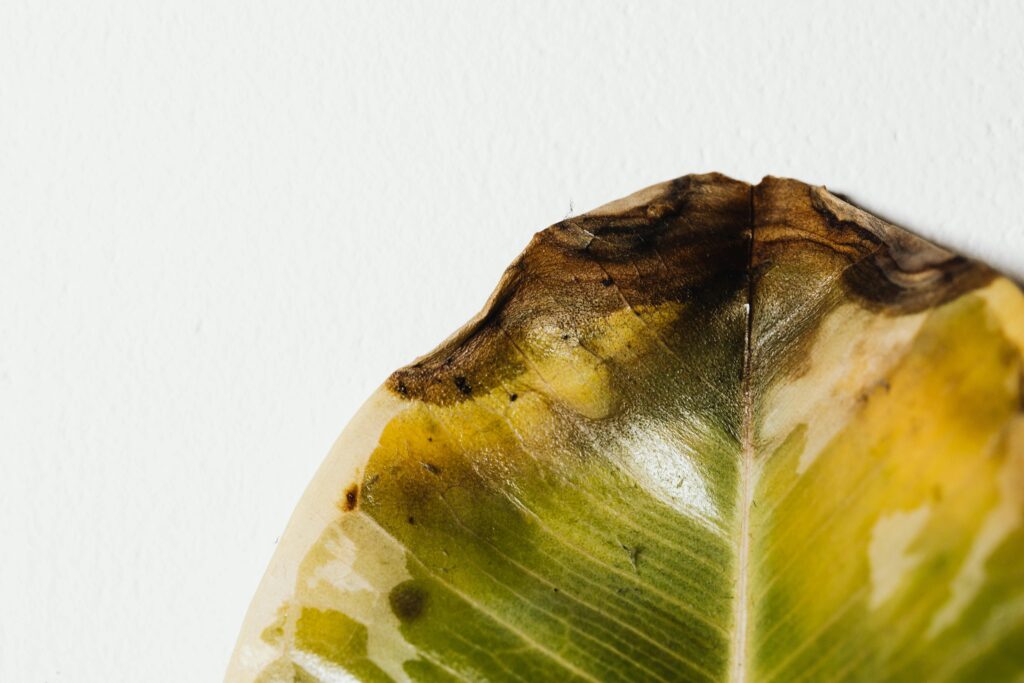
The first and foremost reason I stopped using chemical pesticides in container gardening is the harsh effects they had on my plants. In the beginning, I used them even for early-stage or minor pest attacks — but instead of killing the pests, they ended up wilting or burning the plant leaves. From my experience, chemical pesticides should only be considered if the pest infestation in potted plants is severe and when natural pest remedies haven’t worked.
In container gardening pest control, success depends more on routine care and gardening practices than on pesticides. To be honest, using pesticides is only 1 out of 10 parts of the solution. The remaining 90% lies in maintaining plant health, following regular checks, and taking preventive steps. If you’re not consistent with care, even the best pesticide won’t save your plant. So, it’s important to understand the care part, along with using the organic pesticides for container plants I personally recommend and use.
My decision to avoid synthetic fertilizers and pesticides isn’t only about reducing environmental damage or air pollution. I also find it physically uncomfortable — spraying those chemicals makes it hard for me to breathe, likely because of my mild wheezing issues. Beyond that, chemical pesticides leave behind salt residues that clog the plant’s air pockets and interfere with the potting mix, affecting both the roots and drainage.
Another major concern is the impact on soil health. Overusing synthetic garden products can damage the microbial life in potting soil. Plus, you’ll stop seeing natural allies like ladybugs, praying mantis, and pollinator insects around your garden — they simply won’t visit chemically treated plants. And if you have pets or small children, using toxic sprays around them is just not an option.
On the other hand, using natural pest control solutions along with proper pest prevention practices offers a safer and more sustainable approach. These methods gently remove pests and prevent future attacks without harming the plant, environment, or your breathing space. They’re chemical-free — no harsh fog in the air, no fear of harming beneficial bugs, and no damage to the ecosystem in your pots.
🐛 Common Pests I Face in My Container Garden

I absolutely hate pest attacks on my plants — it feels like they drain all the joy from my garden overnight. But over the years, I’ve learned that these common pests in container gardening can be controlled — if caught early. Below are the pests I often battle in my potted plants, with everything you need to know about them.
1. Aphids
Season: Spring to early monsoon
Why they’re attracted: Tender new shoots, juicy sap, over-fertilized plants with soft growth
Early Signs: Sticky leaves (honeydew), distorted or curled new leaves, black sooty mold
Side Effects: Weakens the plant by sucking out sap, stunted growth, invites ants
Organic Pest Control:
Spray neem oil (1 tsp neem oil + ½ tsp liquid soap + 1L water)
Wipe with mild soapy water
Attract ladybugs (natural predators)
2. Mealybugs
Why they’re attracted: Poor air circulation, excess humidity, sweet plant sap (especially in indoor plants and succulents)
Early Signs: White cottony clusters on leaf joints or undersides, slow growth
Side Effects: Sucks sap, causes leaf drop, attracts ants
Organic Pest Control:
Dab with cotton dipped in rubbing alcohol
Spray diluted neem oil
Isolate heavily infested pots
3. Whiteflies
Season: Warm and humid weather, especially post-monsoon
Why they’re attracted: Overcrowded pots, soft-leaved plants, damp environment
Early Signs: Tiny white flies flying when disturbed, yellowing leaves, sticky residue
Side Effects: Weakens plant, spreads viral diseases, sooty mold due to honeydew
Organic Pest Control:
Use yellow sticky traps
Spray garlic-chili solution weekly
Encourage natural predators like lacewings
4. Spider Mites
Season: Hot and dry months (summer peak)
Why they’re attracted: Dry conditions, under-watered or stressed plants, dusty leaves
Early Signs: Fine webbing under leaves, yellow spots or speckled leaves
Side Effects: Rapid leaf drop, weak growth, dried foliage
Organic Pest Control:
Mist plants regularly (they hate humidity)
Neem oil or horticultural oil spray
Wash leaves with lukewarm water weekly
5. Ants
Season: Year-round, especially active during monsoon and summer
Why they’re attracted: Honeydew from aphids/mealybugs, sugary organic matter in soil
Early Signs: Ant trails, disturbed soil surface, aphid/mealybug presence
Side Effects: Protect and farm sap-sucking pests, disturb plant roots
Organic Pest Control:
Sprinkle cinnamon or turmeric around the pot
Use clove or peppermint essential oil spray
Clean honeydew regularly to break the ant-pest cycle
6. Caterpillars
Season: Monsoon and post-monsoon
Why they’re attracted: Leafy plants, flowering plants, or those near lights
Early Signs: Holes in leaves, green droppings on soil, hiding caterpillars under leaves
Side Effects: Severe defoliation, young buds eaten, plant stress
Organic Pest Control:
Handpick caterpillars in early morning
Spray neem or chili-garlic solution
Use crushed neem cake in topsoil
🌿 My Natural Pest Control Routine: Weekly Practices
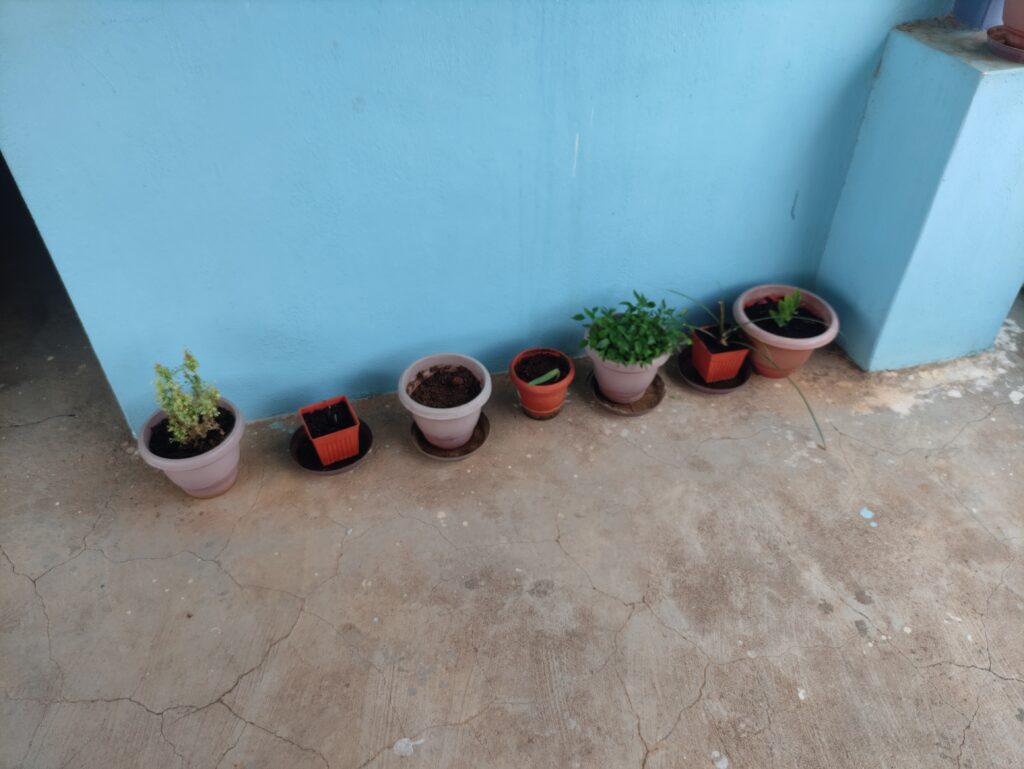
Container gardening demands a bit more attention when it comes to pest control. Over the years, I’ve developed a weekly routine that helps me catch pest problems early and keep my plants safe without using harmful chemicals.
a. Weekly Morning Checks
While watering your plants (usually every 2–3 days), take a moment to inspect them closely for any early signs of pests in container plants — like wilted leaves, white patches, black dots, or sticky residue. The most common pest hiding spots are at the leaf nodes, edges, and especially underneath the leaves.
Always be more alert during humid weather or if one of your plants was recently infested. A quick visual scan while watering can prevent serious outbreaks and save your plant early on.

Also, if you spot holes or movement in the topsoil, check at night — it could be soil gnats, snails, or other soil-dwelling pests active after dark.
b. Weekly Neem Oil Spray
If you find a plant with mild pest issues, the first step is to quarantine the affected plant. This stops pests from spreading to nearby pots.
Next, examine surrounding plants closely. If others show early signs, separate them too — even if they aren’t heavily infected. This simple habit has saved so many of my plants.
After separating the affected pots, spray the rest with a preventive neem oil solution:
Neem Spray Recipe:
1 tsp neem oil + ½ tsp liquid soap + 1L water
This organic pest control spray for potted plants helps prevent pest infestations, especially during humid seasons or peak pest attack periods.


Pest | Peak Season | Triggers |
Aphids | Early Spring – Early Monsoon | Tender new growth, over-fertilized soft shoots |
Mealybugs | Warm, humid air, poor circulation | |
Whiteflies | Post-Monsoon – Winter (Sept–Jan) | Damp conditions, crowded pots |
Spider Mites | Hot & Dry (April–June) | Dry soil, low humidity, dusty leaves |
Ants | Year-Round; Peak in Summer | Sweet sap from aphids/mealybugs, moist soil |
Caterpillars | Monsoon – Post-Monsoon (July–Oct) | Leafy growth, humidity, outdoor lighting |
c. Garlic & Chilli Spray (Bi-Weekly or As Needed)
One of my favourite homemade organic pesticides is garlic and chilli spray — it’s strong, natural, and works wonders on soft-bodied pests.
How to Make It:
Soak garlic cloves (with peel) and dry red chillies in water overnight.
Strain and dilute the extract the next day with clean water.
(Optional method: Boil garlic and chillies together, cool down, strain, then dilute.)
This spray works effectively against aphids, whiteflies, spider mites, mealybugs, thrips, fungus gnats, slugs, and snails. These sap-sucking pests can weaken a plant quickly if unnoticed. Slugs and snails eat through leaves and interfere with photosynthesis.

d. Soap & Water Spray for Quick Action
For moderate-to-severe pest outbreaks, you can use insecticidal soap spray for container plants. If you don’t have that, a mix of dish soap + neem oil + water works as a fast DIY solution.
For more serious infestations, especially involving spider mites or whiteflies, sprinkle diatomaceous earth around the soil surface. It’s a natural powder that dehydrates pests but is safe for your plants.
e. Wiping with Cotton & Alcohol (for Succulents & Thick Leaves)
Some pests are stubborn — especially mealybugs or scale insects that cling to tough-leafed plants. For these, physical removal is best.
Use cotton pads or earbuds dipped in alcohol or neem solution to wipe off pests.
After pests are gone, rinse the leaves with plain water.
Gently wipe with dry tissue to remove any chemical or salt buildup from sprays.
For succulents and rubbery plants, this technique avoids overwatering and still keeps the leaves pest-free.
💨 Think wiping leaves is enough? Think again. Discover smarter dust-cleaning hacks for terrace plants in India.
🌼 Plant Companions & Natural Repellents
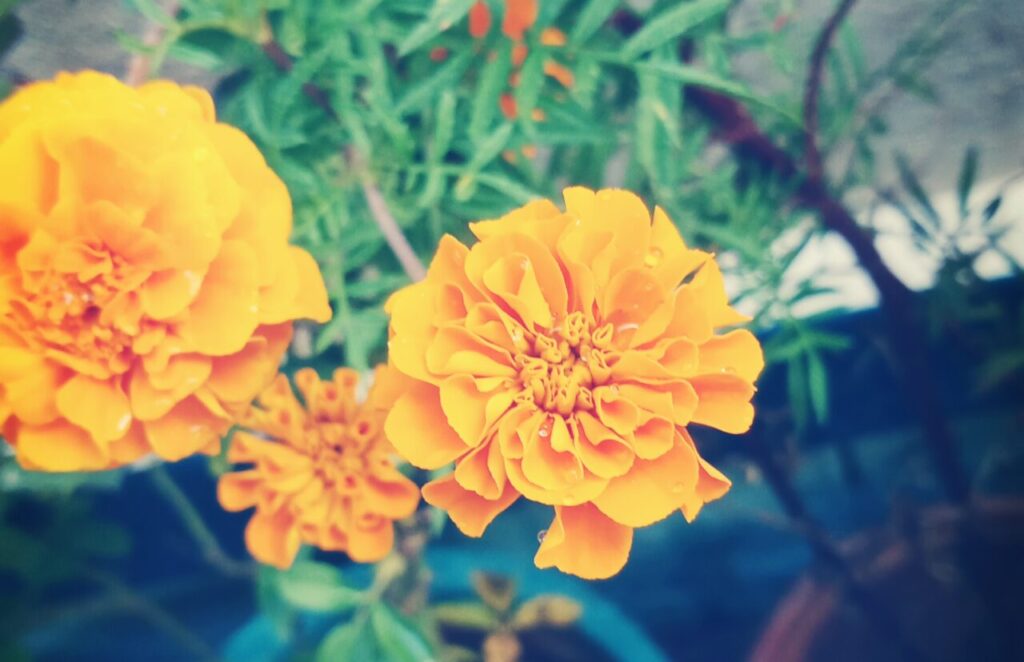
When people talk about companion planting, they often imagine it’s only for large vegetable gardens or farms. But let me bust that myth right here:
“Companion planting only works in big gardens” — False!
I’ve been practicing companion planting in container gardening for years, and it makes a real difference — especially when it comes to natural pest control.
By simply growing a few pest-repelling plants around your pots, you can reduce the chances of infestation without using any sprays at all.
Here are some of my favourite plant-based natural repellents:

Why It Works: Marigold roots release a natural compound that repels nematodes and soil-borne pests. Its strong scent also deters aphids, whiteflies, and mosquitoes.
Where I Use It: I keep marigolds near my flowering plants and veggies in pots — they look great and act as a pest shield.

Why It Works: Basil’s intense aroma naturally keeps away flies, mosquitoes, and thrips. It’s also known to enhance the growth of nearby plants, especially tomatoes and peppers.
Where I Use It: I place basil pots near my veggies and herbs. The scent not only deters pests but also adds freshness to my garden area.

Why It Works: Mint’s strong menthol scent is effective against ants, aphids, and cabbage moths. But be warned — mint can spread aggressively, even in pots.
Where I Use It: I grow mint in separate containers and place them near pest-prone plants like leafy greens or flowering varieties.

Why It Works: Garlic naturally repels aphids, spider mites, and whiteflies. It can also improve soil health and deter fungal infections.
Where I Use It: I often plant a garlic clove directly in the same pot as ornamental plants. The garlic root exudes natural sulphur, acting as a mild pesticide.

Even in container gardens:
Companion plants confuse pests with scent diversity
They act as living borders or decoys for pest attack
Many of them are edible — so you get double the value: beauty + function
It’s not about the size of your garden, it’s about smart placement. A few well-chosen plants can work together like a mini pest-defense team, naturally and beautifully.
🐞 Encouraging Beneficial Insects in Your Container Garden
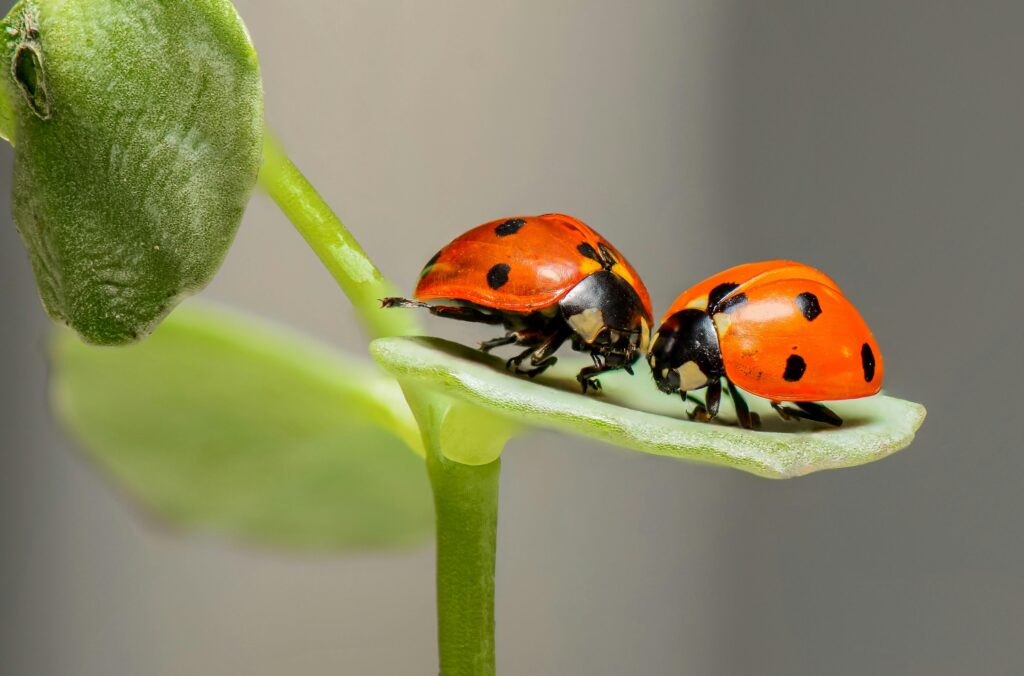
When we think of pest control, most people reach for sprays — even organic ones. But over time, I’ve realized some of the best pest control allies don’t come in bottles — they come with wings and tiny legs.
Yes, I’m talking about beneficial insects like ladybugs, hoverflies, lacewings, and more. They’re nature’s own pest control squad, and encouraging them into your container garden can make a big difference — without harming your plants or the environment.

Ladybugs are a blessing. I’ve spotted them more than once feeding on aphids in my pots — especially on chili, marigold, and flowering plants. They can munch down hundreds of aphids in a single day. And they don’t need any care — just don’t kill or spray near them!
Hoverflies are often mistaken for bees, but they’re harmless to humans and deadly to soft-bodied pests. Their larvae feed on aphids, thrips, and mealybugs. I usually see them near herbs and wildflowers.
These tiny helpers can balance your garden naturally, if you just let them in.

If you keep cleaning every dry leaf, spraying every corner, and wiping off every bug you see — you might be harming the good guys too.
I’ve learned to avoid over-sanitizing my containers. A bit of leaf litter or one wild corner in your balcony or terrace can become a safe haven for beneficial insects.
Tip: Let a few flowering herbs go to seed — like dill, coriander, or fennel — they attract parasitic wasps and predatory insects that help control hidden pests.

No matter how small your space is, you can build biodiversity in a container garden. And it’s not about size — it’s about diversity.
Here’s what works for me:
Keep a mix of flowering plants, herbs, and native plants
Avoid excessive spraying, even with organic solutions
Let wildflowers bloom — they attract natural pollinators and hunters
Add small water trays or pebbled dishes — many beneficial insects need water too
This not only brings beneficial insects to your potted plants, but also improves pollination, soil health, and overall plant growth.
🐜 Natural Ant Control in Pots
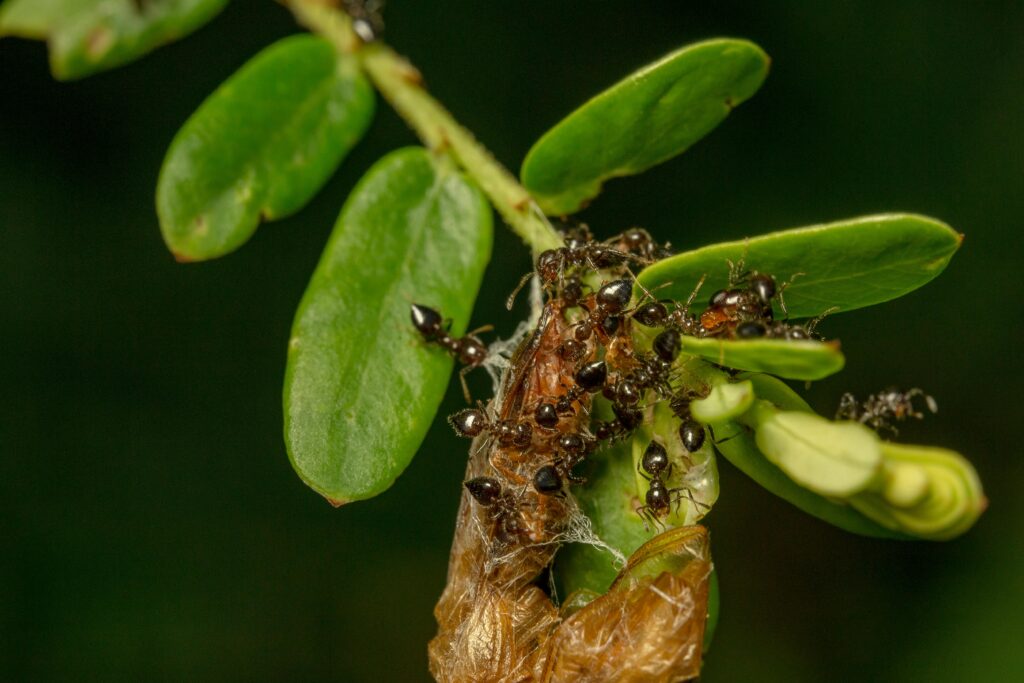
Ants are one of the most annoying but misunderstood garden pests. In small numbers, they might seem harmless, but if left unchecked, they farm aphids and mealybugs by protecting them and feeding on their sticky honeydew. This creates a serious pest cycle in your container garden.
And here’s the catch — while you may want to get rid of ants, you shouldn’t destroy the entire soil ecosystem in pots just for that.
That’s why I only rely on natural ant control methods that work with the garden, not against it.


Sprinkle cinnamon around the base of the pot or near the ant trail. The strong smell confuses their scent trail and keeps them from returning.
I’ve used this especially during monsoon and summer, when ants are most active in pots.

Mix a few drops of clove essential oil with water and spray around the plant pot, near drainage holes, or wherever ant movement is visible. It’s a strong deterrent — and bonus — it smells great!

Sprinkle turmeric powder in a line around the pot or on the ant entry points. It creates a natural barrier that ants avoid crossing.

Instead of using harsh ant killers, I focus on breaking the honeydew connection. Since ants protect sap-sucking pests like aphids, mealybugs, and whiteflies, getting rid of those pests naturally reduces ant presence too.


Most chemical ant powders destroy beneficial microbes and create residue buildup in potted plants. That’s why I’ve completely stopped using them.
Using gentle natural methods like cinnamon, turmeric, and clove oil allows your plants to breathe, keeps the potting mix healthy, and lets beneficial insects (like ladybugs and pollinators) thrive without getting harmed.
💸 Budget-Friendly Tips for Natural Pest Control
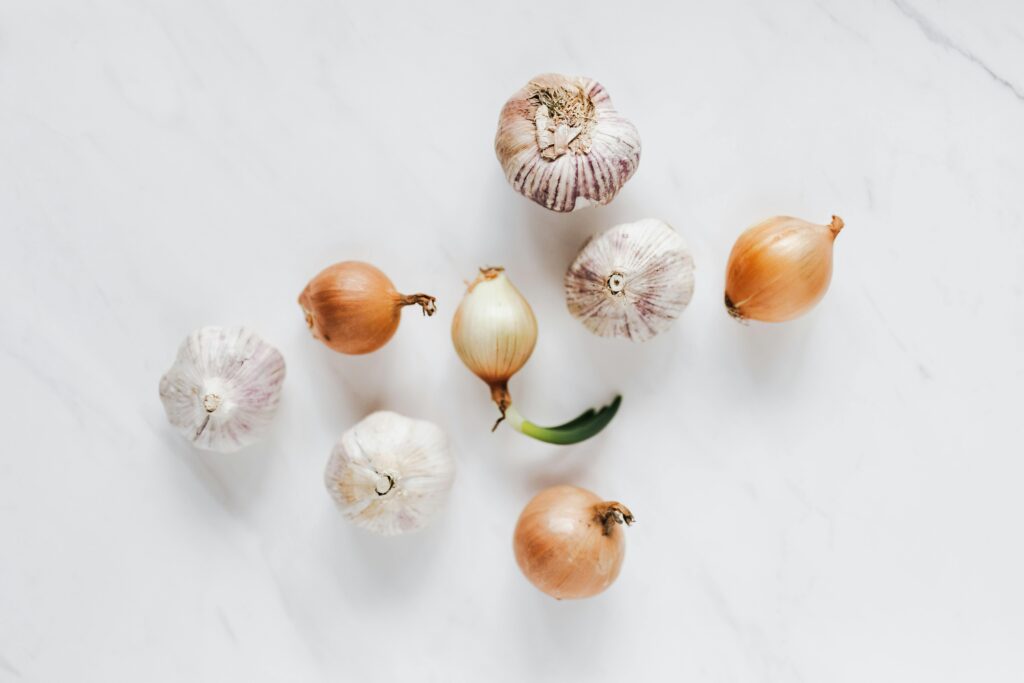
Let’s be real — not everyone can afford expensive organic sprays or imported pest control kits. But that doesn’t mean you need to compromise your garden’s health.
Over the years, I’ve discovered that natural pest control in container gardening can be done on a tight budget — often with items already in your kitchen or local shop.
🌿 Neem Oil: The Hero of Organic Pest Control
Neem oil is the easiest and most beginner-friendly organic pest solution. It’s available in most local gardening shops. To turn it into a safe pesticide:
DIY Neem Spray Recipe
1 tsp neem oil
½ tsp dish soap liquid (acts as an emulsifier)
1L water
Mix well and spray weekly or bi-weekly during pest-prone seasons.
👉 If neem oil is hard to find, you can try neem oil concentrates — they’re more potent and effective than harsh chemical sprays.
🧄 DIY Organic Pesticides from Your Kitchen
If you want chemical-free pest sprays, your kitchen already has the ingredients. Here are a few I use regularly:
1. Garlic-Chili Spray (For Aphids, Mealybugs, Whiteflies)
5 garlic cloves (with peel)
2–3 dry red chilies
Soak overnight or boil and cool
Strain and dilute in 1L water
Spray on leaves and soil once a week
2. Onion-Garlic-Clove Mix (Antifungal + Pest Repellent)
1 onion + 3 garlic cloves + 2 cloves (spice)
Blend with water, strain, and dilute
Spray for fungus gnats, thrips, soft-bodied pests
3. Cinnamon Water (For Ants & Fungal Gnats)
Soak cinnamon sticks overnight or boil
Use cooled water to spray soil or pot edges
✅ These sprays are non-toxic, budget-friendly, and safe for pets and pollinators.
🪴 Best No-Cost Pest Prevention: Smart Garden Habits
Sometimes the best pest control isn’t a spray — it’s prevention. Here’s what I’ve learned through trial and (many) errors:
✅ Avoid overwatering — damp soil and humid pots invite soft-bodied pests and fungal issues.
✅ Use quality, well-draining potting mix — soggy soil leads to root rot and attracts soil-dwelling pests.
✅ Avoid synthetic fertilizers — they disrupt natural microbial life and scare away beneficial predators like ladybugs and lacewings.
✅ Space your pots properly — overcrowding reduces airflow and creates dark hiding spots for pests.
✅ Quarantine new saplings — don’t mix them with your healthy plants until you’re sure they’re pest-free.
✅ Don’t leave plant debris or dead/infected plants — pests thrive on decaying organic matter.
✅ Avoid unsterilized garden soil — it can bring hidden pest eggs or fungal spores into your pots.
✅ Clean your tools and pots after use — especially if used on an infected plant.
✅ Clean and store empty pots properly — use mild soap or neem water before reusing.
✅ Don’t compost infected plants or meat/dairy waste — they attract unwanted bugs and odors.
✅ Add neem cake to your potting mix — it improves pest resistance naturally and adds slow-release nutrients.
❌ Don’t overfeed with nitrogen or microbial boosters — it makes plants tender and more attractive to pests.
📆 Seasonal Adjustments for Pest Control in Container Gardening
One thing I’ve learned in 7 years of container gardening is that pest care isn’t a one-time fix — it changes with the seasons. Each season brings its own set of challenges, from sticky aphids in spring to sneaky spider mites in summer. Knowing what pests peak when and adjusting your care routine accordingly can save your plants and your sanity.
Let’s break it down by season, so your pest control routine stays a step ahead.

Spring is a joyful season — new leaves, blooms, and plant growth everywhere. But that fresh, juicy growth also attracts aphids, ants, and mealybugs.
Spring Pest Prevention Tips:
Start weekly neem oil spray before pests appear.
Avoid over-fertilizing — it invites soft-bodied pests.
Inspect new growth for curling or stickiness (early aphid signs).
Quarantine nursery plants before adding them to your pot cluster.

Hot, dry months = spider mites, fungus gnats, and soil pests thrive. Potted plants tend to dry faster and suffer heat stress, making them more vulnerable.
Summer Pest Prevention Tips:
Increase humidity around plants by misting or placing pebble trays.
Use cinnamon powder to stop gnats and ants near soil.
Weekly morning checks — look for webbing under leaves.
Spray garlic-chili solution in early mornings every 10 days.

The monsoon season feels fresh, but the rainwater and humidity turn your pots into a buffet for snails, slugs, caterpillars, and fungal spores.
👉 Read my blog on budget-friendly tips to protect pots from heavy rain and keep your container garden safe this monsoon.
Monsoon Pest Prevention Tips:
Add neem cake to your potting mix to improve resistance.
Remove dead leaves daily to avoid fungal buildup.
Use turmeric or coffee grounds as a barrier against slugs/snails.
Don’t overwater — check soil before watering!

As temperatures drop, whiteflies and root pests start appearing — especially if pots were stressed during monsoon.
Post-Monsoon Pest Tips:
Start bi-weekly neem + soap spray even if no pests are visible.
Check under leaves for tiny white clusters (whiteflies or scale).
Avoid crowding — give plants enough air circulation.
Wipe dusty leaves — many pests settle on unclean foliage.

In cooler months, many container gardeners shift their plants indoors or closer to walls. This lack of airflow invites mealybugs, scale insects, and fungus gnats.
Winter Pest Tips:
Clean and inspect pots before bringing them indoors.
Avoid stagnant water in trays — it attracts gnats.
Wipe succulent leaves with neem spray to keep mealybugs away.
Increase light and space between indoor plants.
🌿 Final Thoughts: Embrace Imperfection & Be Consistent
Let me tell you — there’s no such thing as a perfect garden without pests or plant problems. In fact, healthy, fast-growing plants naturally attract pests. That doesn’t mean you’re doing something wrong — it means your garden is alive and thriving.
You can minimize pest attacks with early detection, consistent observation, and by following the natural pest prevention practices we’ve discussed. Most of the time, that’s enough to avoid damage. But if a pest does show up — that remaining 10% — you can treat it using the organic pest control sprays for container plants listed above. And don’t forget to quarantine infected plants to stop the spread.
But here’s the truth…
Even after doing everything right, some plants may not survive. Sometimes, a sap-sucking pest spreads before you notice it, or the plant itself just isn’t strong enough. That’s not failure — that’s real gardening.
🌱 The Power of Experience Over Perfection
Don’t judge yourself by one dying plant or a failed season. Every pest attack, every leaf drop teaches you what works and what doesn’t. And that kind of insight doesn’t come from reading alone — it comes from hands-on experience, trial, and error.
Be patient. Be consistent. And most importantly — don’t give up on your plants or your inner gardener.
Gardening isn’t just about growing plants — it’s about growing through the process. And trust me, the joy of getting it right (after getting it wrong) is worth every bug battle.
So the next time pests show up — take a breath, observe, act calmly, and move on. No panic. No guilt. Just natural pest control, real garden care, and a little patience.
❓ FAQ: Natural Pest Control in Container Gardening

Yes, neem oil spray is safe for flowering plants, as long as it’s used in the correct dilution. Avoid spraying during full sun or peak bloom time — neem can cause flower burn if sprayed directly under intense sunlight. Spray early morning or late evening, and rinse flowers with plain water the next day if needed.

Always spray early morning (6 AM – 8 AM) or early evening (5 PM – 6:30 PM). This prevents sun-scorch, allows sprays to stay longer, and gives you better visibility to spot pests. Spraying during harsh midday sun can cause leaf burns or fast evaporation, making the solution ineffective.

Yes, most DIY organic pest control sprays, like garlic-chili or neem water, are safe for herbs like mint, basil, coriander, etc. Just make sure you:
Use correct dilution
Avoid spraying right before harvest
Rinse the leaves with plain water before use
These sprays keep pests off without adding harmful residues.

As a general routine:
Preventive sprays (neem oil, garlic-chili) – once every 7–10 days
After pest detection – spray every 3–5 days until pests are gone
Always avoid over-spraying, and give your plants time to breathe between treatments
Combine sprays with weekly pest checks and good garden hygiene for best results.
💬 Got a Pest Story or a Natural Hack? Let’s Talk!
Have you ever lost a plant to pests? Or maybe you’ve discovered your own clever, budget-friendly way to keep bugs at bay?
I’d love to hear your real gardening stories! Drop your pest battles, homemade remedies, or natural pest control wins in the comments — let’s help each other grow better.
👇 Leave your questions below — I personally reply to all comments, and your tip might just save someone else’s plant!
While you’re here, don’t forget to check out these helpful guides:
👉 Best Potting Mix for Healthy Container Plants
👉 How to Choose the Right Fertilizer for Potted Plants
👉 Budget Pots vs Premium Pots – Which One’s Worth It?
🌱 Whether you’re just starting or 7 years into this like me — you’re not alone in this garden journey. Let’s grow naturally, one pot at a time.

Pingback: Choosing the Right Containers: Real Tips from 7 Years of Container Gardening
Pingback: Top 3 Essentials for Container Gardening Success: Sunlight, Space & Drainage Explained
Pingback: 7 Proven Winter Container Garden Tips + Mistakes to Avoid